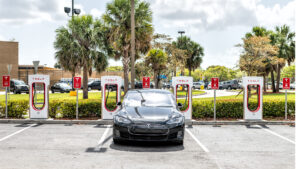This story was originally published by Grist. You can subscribe to its weekly newsletter here.
By Jake Bittle, Grist
Although the global market for electric vehicles has surged over the past decade, EVs still account for only a small percentage of new cars sold in the United States. Since 2014, their domestic market share has risen from around 1% to around 6%. The Biden administration has far bigger plans for the next eight years: Under a sweeping set of vehicle emissions rules unveiled by the Environmental Protection Agency on Wednesday, EVs would make up as much as two-thirds of all U.S. car sales by 2031 — a more than tenfold increase from current levels.
The EPA’s new pollution standards target conventional passenger cars, vans and pickup trucks. They set much stricter emission limits for planet-warming gasses like carbon dioxide and methane as well as toxic pollutants like nitrogen oxide. When the vehicle emissions rules take effect, new automobiles will be allowed to spew less than half as much carbon as they can now. A separate set of rules will limit carbon emissions from larger heavy-duty trucks.

In theory, auto manufacturers can choose how they achieve compliance, but the EPA believes many of them will opt to manufacture EVs rather than trying to design combustion vehicles that meet the new standards. Automakers like Ford and General Motors have already claimed they plan to phase out production of gasoline-powered cars, but these rules would speed up their timelines. If they work as designed, the regulations would avert the equivalent of more than two full years of current U.S. carbon emissions.
But that’s a big “if.”
Assuming the new rules survive inevitable legal challenges from Republican-led states, manufacturing and selling that many new electric cars will require an industrial buildout unprecedented in scale and speed, not to mention millions more tons of critical minerals like lithium and cobalt. The rules are some of the most ambitious climate regulations in U.S. history, but it will take a Herculean effort from the American automotive industry to comply — well beyond the industry’s recent investments and the incentives included in the historic climate law Congress passed last summer.
“The momentum is already building for the adoption of EVs,” said Ellen Kennedy, who leads the carbon-free transportation program at RMI, a think tank focused on sustainability. “We’ve had just extraordinary growth with regard to EV infrastructure and chargers. We need a lot more in order to be ready for the projected demand that would stem from adoption of a rulemaking like this.”
Automakers and battery manufacturers will have to build new plants, source new minerals from around the world, and hire and train thousands more workers, according to Kennedy. Many of them are already doing this, but “they need to do more of what they’re doing,” she added.
There’s also the matter of charging stations. The U.S. currently needs at least 2 million additional charging stations to support new EVs as they hit the road, or about 8 times as many as exist right now. The EPA’s standards will only increase that need if they spur the growth in the market that’s intended. Lack of available charging infrastructure is already the No. 1 concern that keeps Americans from purchasing an EV.
And for EV adoption to reduce emissions, the electricity in those charging stations will need to get cleaner. Last year saw renewables surpass coal in terms of electricity generated in the U.S. for the first time, but a glut of new EVs could strain the power grid and force utilities to burn more natural gas. The EPA’s modeling admits such a ramp-up is likely but says “those projected impacts decrease over time because of projected increases in renewables,” so that vehicle carbon emissions would fall 47% from current levels by 2055.
The final concern is price. While EVs have dropped in price over the past decade and are approaching cost parity with some combustion vehicles, they are still unaffordable for many Americans, especially those in disadvantaged communities — who often live in what environmental justice activists call “charging deserts.” The EPA said that its new vehicle emissions rules would likely raise average prices for both new and used vehicles of all types, but it also said that EV consumers would save money on gasoline and maintenance, which might offset the price increase.
These price concerns persist in spite of the EV tax credits included in last year’s Inflation Reduction Act, which may not be as transformative as lawmakers hoped: Because the tax credits require automakers to source minerals and battery parts from within the U.S., many models won’t be eligible until the U.S. completes the years-long process of building a domestic supply chain.
Kennedy said that in addition to helping in the climate fight, the rulemaking will have a transformative impact for public health. Tailpipe emissions are the leading cause of pollution in many cities, and tens of millions of people experience negative health effects from automobile pollution.
“There’s such a connection between transportation, air quality and public health,” said Kennedy. “This is an area where we can really go to work on goals about inequality and health. It’s extraordinary.”
This article originally appeared in Grist at https://grist.org/transportation/biden-epa-vehicle-emissions-rules-electric/.
Grist is a nonprofit, independent media organization dedicated to telling stories of climate solutions and a just future. Learn more at Grist.org



